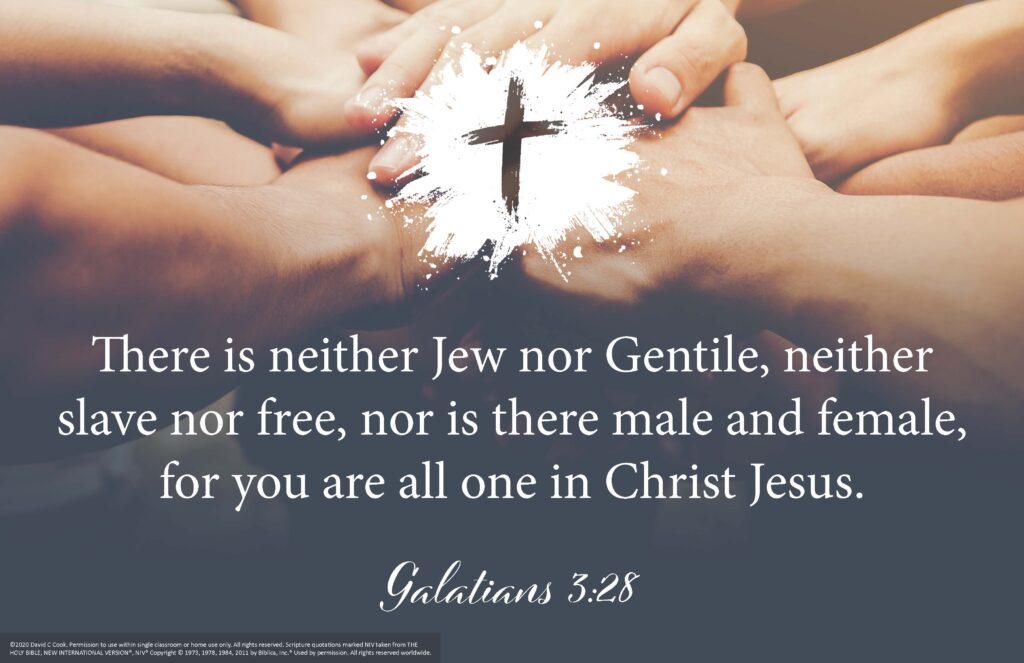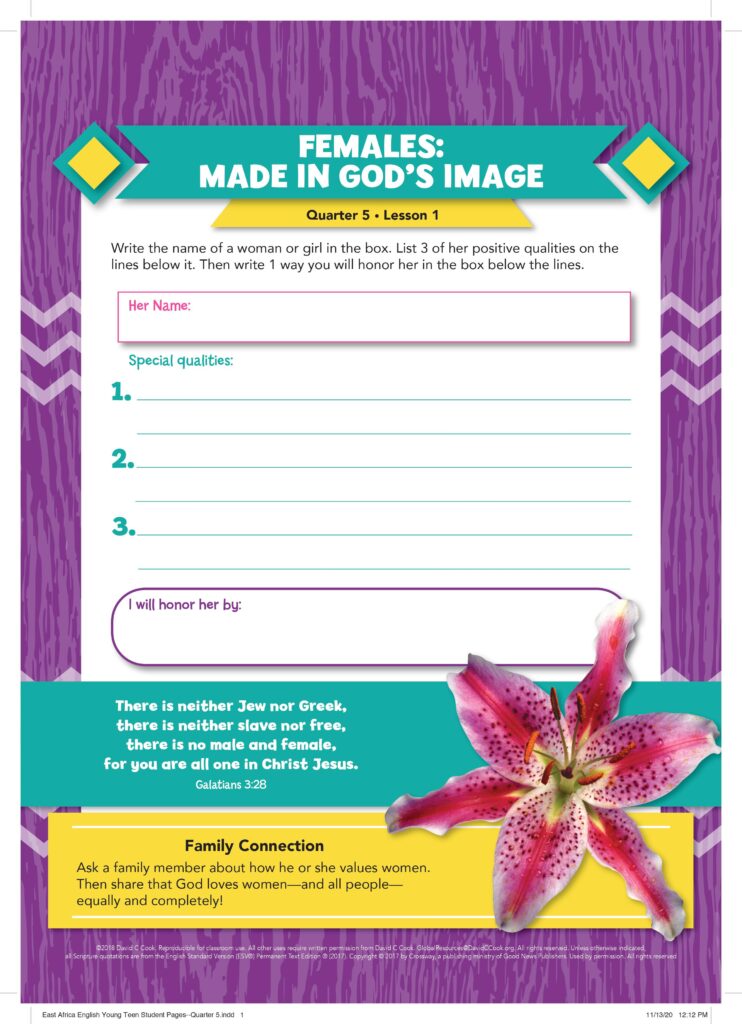During the lesson, the information for you to know is written in regular type, and what we suggest speaking or reading aloud to children is in bold. All resources for this lesson, including the Teacher Guide, Student Page, Family Connection Card, and other resources can be downloaded in a ZIP file by clicking on the following link:
In some lessons you will find "resource articles." These are articles written by experts from around the world to help equip you for your work with children and adolescents. Share them with parents or guardians if you consider it appropriate.
So God created mankind in his own image, in the image of God he created them; male and female he created them.
Genesis 1:27
God created all people in His image. Every boy, girl, man, and woman has been made to resemble God—not in the physical body and appearance but in how we think, act, and share our lives with others. Our God reasons, creates, loves, and communicates, and He designed each of us to do the same.
God did not give these incredible gifts only to men but to all people: both male and female. Yet women are often treated as less valuable. How are women seen and treated in your community? What rights and restrictions are placed on them? How do most people talk about and act toward women? Are women appreciated and valued? Ask God to show you how much He loves and values girls and women. Think of ways you can treat the women in your life with honour. Ask God to help you view women and girls as He does—as His beloved creations, made in the image of their marvellous Creator.
Encourage the students to ask a family member about how he or she values women. The students can then share that God loves women and girls—and all people—equally and completely!
Teacher Tip: If possible, email or text the Family Connection Card to the families of your students.
Welcome your students by name as they arrive. If there are any new students, introduce yourself and ask them to share about themselves. If they are shy or not interested in talking, continue to show them warmth, but do not pressure them to talk. Your care for every student helps create an atmosphere that encourages students to be open to learning and sharing their thoughts.
Explain to the students that you will start today’s class with an activity about mirroring one another. Have your students pair up. If you have an odd number of students, you can pair up with a teen. Have the students stand facing each other, about 1 meter apart. One partner will be the “leader.” The other will be the “mirror.”
In each pair, the leader will make simple movements, such as waving an arm or tapping a foot. The mirror student will follow the leader’s movements, as if reflecting them in a mirror. The mirror student’s goal is to mirror her partner perfectly. Give students about 1 minute to play. Then have the pairs switch roles so the leader becomes the mirror and the mirror becomes the leader.
Have the students sit down to talk about the game.
Our own images looking back at us.
Optional: If you brought a mirror, pass the mirror around and let the students take turns looking at themselves in the mirror.
The images we see in a mirror look just like our physical bodies. But there are parts we cannot see—parts that make us like the One who created us. We are all created in God’s image. Let’s find out what that means.
The Bible tells us that we are all created in God’s image.
Have a student read Genesis 1:27 aloud from the Bible. If possible, show The Action Bible image while you read this verse.
So God created mankind in his own image, in the image of God he created them; male and female he created them.
Genesis 1:27
If possible, show The Action Bible images as you tell the story.

God created people, males and females, in His image.
In Genesis 1:27, we see that God created all human beings—male and female—in His image.
God made people to reflect His character in the world.
Possible answers include we act like Him and we love Him.
When the Bible tells us that God made humans in His image, it means we are a reflection of Him, like our images in the mirror reflect us. This does not mean we physically look like God. However, like God, we can think, create, and communicate. Relationships are important to God, so we are created to live in community and to have relationships with others.
Each of these things is a unique way of showing that we are made in God’s image and reflect Him. Unfortunately, in many cultures and societies, some people are valued more highly than others. And how we treat people is based on how we value them. People with disabilities are often treated as though they have little value. But they were made in the image of God! People from different ethnic groups, languages, genders, and social groups are often treated as if they have little or no value. But they are all made in the image of God, and He loves them just as much as He loves you! The Bible tells us that all people are made in the image of God.
In some communities, women and girls are considered less valuable than men and are treated with less honour. But women and girls are made in the image of our amazing Creator!
Students’ answers will vary depending on how women are valued in your community.
In the story of creation, the Bible tells us the special place of women in God’s plan for the world.
Have a student read Genesis 2:18 aloud from the Bible.
The LORD God said, “It is not good for the man to be alone. I will make a helper suitable for him.”
Genesis 2:18
God created woman to be a “helper suitable for” Adam. In the original language of the Old Testament, this word means “one who supplies strength,” and it is used almost exclusively about God as the One who helps and saves His people.
God created Eve to be a helper who helped Adam by providing the things he lacked. He was to do the same for her. Both shared the image of God, and both were created to meet the needs of the other. Both were equally important.
Help the students to understand that men and women can help one another and enjoy fellowship together because each has different character traits, skills, and strengths.
Allow 2–3 teens to share their thoughts. Then guide the students to think of character traits and roles that are common for men and women in your culture. Help them to see that these skills and traits complement each other and allow men and women to help each other.
The Bible also tells us that women, like men, are heirs to God’s promise of salvation.
Teacher Tip: Explain that an heir is someone who inherits something of value.
Show the Memory Verse poster if you are using it.
So in Christ Jesus you are all children of God through faith, for all of you who were baptized into Christ have clothed yourselves with Christ. There is neither Jew nor Gentile, neither slave nor free, nor is there male and female, for you are all one in Christ Jesus. If you belong to Christ, then you are Abraham’s seed, and heirs according to the promise.
Galatians 3:26–29

We are all equal in God’s eyes. He loves us all, regardless of our ethnicity, social class, or gender.
God created all of us, and He loves all of us equally—male and female, poor and rich. He loves us no matter what our social class is, no matter what language we speak, and no matter what group we belong to. He loves us no matter what others think of us. He does not love some of us more because of who we are or where we were born. He loves all of us equally. In fact, He loves all of us so much that He sent His Son to pay the price for our sins—not just the sins of some, but the sins of all of us! Jesus died for all people. And God invites all of us to receive salvation and become His children.
Have students find partners and sit down to talk about the following question for 2 minutes.
Ask 2–3 pairs to share what they discussed with the class.
Although some people may not believe women are as important as men, God’s Word shows us that they are. When God created the first woman in His image, He created her to be a helper to the first man and to act as the man’s valued partner. Each of them had qualities and abilities that the other did not have. God also created every woman and girl in His image—and He values them as much as He values the men and boys. Therefore, we should respond to every person in our lives—male and female—with equal respect and honour.
Think of a girl or woman in your life. It might be a family member, teacher, neighbour, or friend. She is created in the image of God. She has special qualities that were given to her by God. Think about a positive quality she has. She may be artistic, intelligent, or generous. She may be good at organizing things, keeping accounts, or teaching.
Give the students a minute to think of this person. Ask them to think of a way they can honour her. Then have them share with their partners how they will honour this woman or girl.
Optional Supplies: Hand out the paper and coloured pencils or markers. Tell the students to draw a picture of the woman or girl they are thinking about. Then have them write her positive qualities below the picture and write down a way they honour and respect her.
If you are using the Student Pages, the teens can draw their pictures and write their responses on their pages.

Some people believe women are less valuable simply because they are women. But this is not what the Bible tells us. God loves all people equally—including women. He has created each woman and girl as a unique individual with special talents, strengths, and gifts. They are made in God’s image.
We can do many things to honour and respect the girls and women in our lives. We can tell our female teachers, family members, and friends that we value them. We can say what we appreciate about them. We can begin to see women as God sees them—as His precious and valuable creations.
For those of you who are young women and girls yourselves, think about how you value yourself. Think of ways you can value yourself as God does. Remember that God created all people in His image. Each person is highly valued and loved by our amazing Creator! As you listen to what God says about you, you will have more confidence to walk through life.
Invite the students to pray with their partners and thank God for the women and girls in their lives. Encourage them to thank God for creating women in His image. Then remind them to thank God for making each of them—women and men, girls and boys—in His image, too.
Close your time with a blessing over your students based on Galatians 3:28.
Blessing: May God, your loving Creator, remind you that all people are equal in His eyes. May you know that He loves and values you not because of where you were born or your social class or because of your racial group but because you are created in His image. May you begin to see yourself and others as He does—as special and unique people who are valued by Him.
Lead the students in singing this quarter’s song, if possible.
Life on Life ©2020 David C Cook. Reproducible for home or classroom use only. All other uses require written permission from David C Cook [email protected]. All rights reserved.